
The Firenza is a model of car offered by Vauxhall from May 1971 until 1975. It was a development of the Viva, but had a distinctive coupé body style (fastback) and only two doors. In South Africa, it was sold as the Chevrolet Firenza until it was replaced by the Chevrolet 1300/1900 during 1975. Its name is derived from Firenze, the name of the Italian city known in English as Florence.

The Vauxhall Viva is a small family car that was produced by Vauxhall in a succession of three versions between 1963 and 1979. These were designated the HA, HB and HC series.
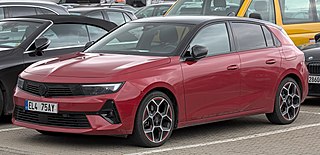
The Opel Astra is a compact car/small family car (C-segment) developed and produced by the German automaker Opel since 1991, currently at its sixth generation. It was first launched in September 1991 as a direct replacement to the Opel Kadett. As of 2022, the car slots between the smaller Corsa supermini and the larger Insignia large family car.

The Vauxhall Cavalier is a large family car that was sold primarily in the United Kingdom by Vauxhall from 1975 to 1995. It was based on a succession of Opel designs throughout its production life, during which it was built in three incarnations. The first generation of Cavalier, launched in 1975 and produced until 1981, was Vauxhall's version of the General Motors 'U-Car' - essentially an Opel Ascona B/ Opel Manta with a few minor visual differences.

The Opel Omega is an executive car engineered and manufactured by German automaker Opel between 1986 and 2004. The first generation, the Omega A (1986–1994), superseded the Opel Rekord. It was voted European Car of the Year for 1987, and was available as a saloon or estate. The second generation, the Omega B, was manufactured from 1994 to 2004.

The Opel Ascona is a large family car that was produced by the German automaker Opel from 1970 to 1988. It was produced in three separate generations, beginning with rear-wheel-drive and ending up as a front-wheel drive J-car derivative.
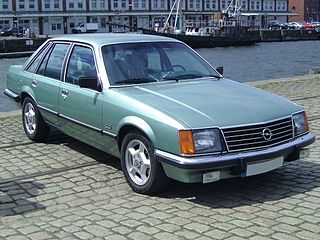
The Opel Senator is a full-size executive car (E-segment) produced by the German automaker Opel, two generations of which were sold in Europe from 1978 until 1993. A saloon, its first incarnation was also available with a fastback coupé body as the Opel Monza and Vauxhall Royale Coupé.

The Opel Monza is an executive fastback coupe produced by the German automaker Opel from 1977 to 1986. It was marketed in the United Kingdom as the Vauxhall Royale Coupé by Vauxhall.

The Opel Rekord is a large family car which was built in eight generations by the German car manufacturer Opel. Between 1953 and 1986, approximately ten million were sold.

The Vauxhall Carlton is a series of large family car/executive car sold in two distinct generations by the Vauxhall division of GM Europe between 1978 and 1994. The Carlton was based on the Opel Rekord E (Mk.1) and Omega A (Mk.2).

The Opel Commodore is an executive car (E-segment) produced by Opel from 1967 to 1982. It is the six-cylinder variant of the Rekord with styling differences. The Commodore nameplate was used by Opel from 1967 to 1982. However, its nameplate/lineage continued until 2020 with the Australian Holden Commodore. The last generation was sold in the United Kingdom primarily as the Vauxhall Viceroy although Opel models were also sold.
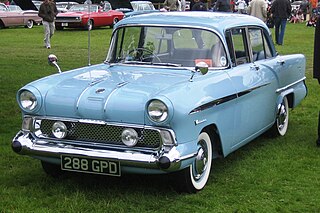
The Vauxhall Victor is a large family car produced by Vauxhall from 1957 until 1976. The Victor was introduced to replace the outgoing Wyvern model. It was renamed Vauxhall VX Series in 1976 and continued in production until 1978, by which time it had grown significantly and was viewed, at least in its home market, as a larger-than-average family car.

The Opel Manta is a rear-wheel-drive sports coupé built by German manufacturer Opel in two generations from 1970 to 1988. The Manta was a mildly sporting coupé based on the Ascona family car, akin to the Ford Falcon-based Mustang and its various imitators such as the Ford Capri. The Manta remained rear-wheel drive for both generations and also saw certain competition success. Its name comes from the manta ray.

The Opel Kadett C is a small family car which was produced by the German automobile manufacturer Opel from 1973 to 1979. The Kadett C, which was the fourth generation of the Opel Kadett, was released in August 1973, and was Opel's version of the General Motors "T-Car". It was the last small Opel to feature rear-wheel drive, and remained in production at Opel's Bochum plant until July 1979, by which time Opel had produced 1,701,076. Of these, 52% had been exported outside West Germany, most of them to markets in other parts of western Europe. In other world markets, however, various badge engineered versions of the Kadett C remained in production as late as the mid-1990s under other GM brand names.

The Opel Corsa is a supermini car engineered and produced by the German automobile manufacturer Opel since 1982. Throughout its existence, it has been sold under a variety of other brands owned by General Motors and also spawned various other derivatives.

The Opel Rekord Series C is an executive car that was introduced in August 1966, by Opel as a replacement for the short-lived Opel Rekord Series B. It was slightly larger all round than its predecessor, from which it inherited most of its engines. It continued in production until replaced by the Opel Rekord Series D at the end of 1971.

The Opel Rekord D series is an executive car that replaced the Rekord C on Opel's Rüsselsheim production lines during the closing weeks of 1971 and launched on the West German market at the start of 1972. It shared its wheelbase and inherited most of its engines from its predecessor, but the bodies were completely new. Also new, announced in September 1972, was the option of a diesel powered Opel Rekord. Early advertising and press material called the new car the "Opel Rekord II" but in due course, the "Rekord II" appellation was quietly dropped and the Rekord D was replaced at the end of the 1977 summer holiday shut down by the Opel Rekord E.

The Opel Rekord Series E is an executive car that replaced the Rekord D on Opel's Rüsselsheim production lines in August 1977, following the end of the summer vacation plant shut-down. It shared its wheelbase and inherited most of its engines from its predecessor, but the bodies were completely new.
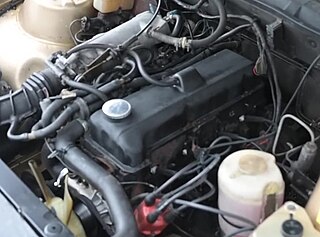
The Opel cam-in-head engine (CIH) is a family of automobile engines built by former General Motors subsidiary Opel from 1965 until 1998, appearing extensively in Opel/Vauxhall badged cars during this period. Both four- and six-cylinder inline configurations were produced. The name derives from the location of the camshaft, which was neither cam-in-block nor a true overhead camshaft. In the CIH engine the camshaft is located in the cylinder head but sits alongside the valves rather than above them, so therefore effectively is still an overhead valve design. The valves are actuated through very short tappets and rocker arms. The engine first appeared in the Opel Rekord B in 1965, and was largely replaced in four-cylinder form by the GM Family II unit as Opel/Vauxhall's core mid-size engine in the 1980s, with the six-cylinder versions continuing until 1994 in the Omega A and Senator B. A large capacity 2.4L four-cylinder version continued until 1998.
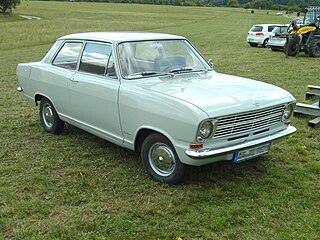
The Opel Kadett B is a car that was launched by Opel at the Frankfurt Motor Show in late summer 1965. The Kadett B was larger all-round than the Kadett A: 5% longer both overall and in terms of the wheelbase, 7% wider and 9% heavier, albeit 10 mm (0.39 in) lower in basic standard "Limousine" (sedan/saloon) form. Production ended in July 1973, with the successor model introduced a month later following the summer shut-down, in August. Unlike its predecessor, it had no relationship with the Vauxhall Viva, which had moved to its own platform for its corresponding second generation.























